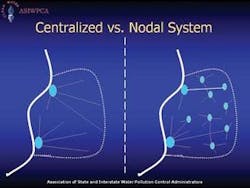Federal Funds Drought Requires Watershed Mind Shift
The federal funding outlook for clean water programs is bleak. State Revolving Fund Loan Programs continue to be reduced by Congressional earmarks, disaster relief rescissions and the possibility of across the board cuts in national discretionary funds. Water programs are feeling the heat.
State water pollution officials are having to make increasingly difficult decisions that could impact the integrity of the Clean Water Act programs well into the future. Nowhere is this more evident than in the Clean Water State Revolving Fund (www.epa.gov/OW-OWM.html/cwfinance/cwsrf/).
• In FY04, the appropriation was $1.35 billion. In FY06, it was $900 million (a 33% cut) and the Bush Administration proposes a rescission taking it down to $730 million (a 46% cut).
• As states are keenly aware, the funding gap for infrastructure financing is well over $300 billion.
• The SRF is achieving good environmental results. In recent years, for reporting states:
- 57% of funds awarded were to achieve compliance.
- 71% were to improve water quality.
- 56% were to protect and restore fisheries.
- 46% were to protect and restore recreational uses.
- 7% were to protect and restore drinking water sources.
• $3.3 billion in loans results in $1 billion cost savings to communities, e.g., due to below market interest rates. Without the SRF, many small and mid-size communities will face great difficulty in financing the required facilities.
Bear in mind, with passage in 1972 of the Federal Water Pollution Control Act, this SRF started out as a $5 billion grant program to build municipal wastewater treatment facilities. In 1981, grants were limited to treatment plant and interceptor sewers only, funding was cut to $2.4 billion and federal cost share cut from 75% to 55%. In 1987, the grants were transitioned to the SRF loan program in place today in all 50 states.
Moving Forward
If we look across both oceans, we see examples of creativity and international trends in environmental regulation with the use of “System Approaches for Clean/Safe Water and Healthy Ecosystems” that can be instructive. The European Union for example is encouraging its member states to:
• Manage to outcomes not outputs
• Integrate pieces of water management through watershed approach
• Elevate environmental needs
• Improve reliability using a Hazard Analysis & Critical Control Points (HACCP) approach
This perspective means moving from managing for pollution abatement to seeking to achieve a specified state of quality - clean water and healthy ecosystems. It also means confronting water’s finite nature instead of viewing it as an inexhaustible resource. This calls for an integrated water management approach for all waters instead of segmented by sector use. And it means combining human needs within a balanced ecosystem.
A Fresh Look
There are those who accuse the water programs of being mature, stable, boring and even “un-sexy.” Like it or not, we have to be aware of our image as a “stodgy old program,” lacking in innovation and creativity. So getting creative let me suggest that we might want to examine:
• New Designs of water and wastewater systems
- Move toward integrated, nodal systems (see Figure 1)
• New Approaches to drinking water protection
- Hybrid approaches to management
• New Techniques
- Advances in membrane technology
• Key Consequences
- Greatly improved treatment options
- Innovations to conventional water and wastewater treatment
- Creation of reuse and desalination options
- Crossover of traditional responsibilities
- More decentralized solutions - highly centralized solutions may no longer be practical
- Increased demand for water and wastewater facilities construction
• Changing System Economics
- Emergence of nodal wastewater systems to create reuse streams for local use
- Plant-level and house-level reuse
- A mix of solutions: centralized nodal decentralized
-Dry-sanitation in very dry/poor areas
The handwriting is on the wall and if we ignore the warning signs, our nation’s environmental infrastructure may well be in peril.
Conclusion
With the billions of dollars for water and wastewater facilities needs in the balance, we can: 1) continue with SRF as is, 2) expand SRF and infuse it with additional funds, 3) continue the SRF and incorporate a hardship community grant program, 4) continue SRF, adding a Trust Fund component, 5) establish a Trust Fund and eliminate the SRF, or 6) eliminate both grants and loans to establish a full cost recovery, user-pays regime. The time for decision-making will soon be upon us and the time to think through these options is now. Otherwise, water quality demanded infrastructure projects may fade into the sunset while we squabble over details and minutiae.
About the Author: Roberta (Robbi) Savage is executive director of the Association of State and Interstate Water Pollution Control Administrators (www.asiwpca.org). She is also president of America’s Clean Water Foundation as well as creator of World Water Monitoring Day.


